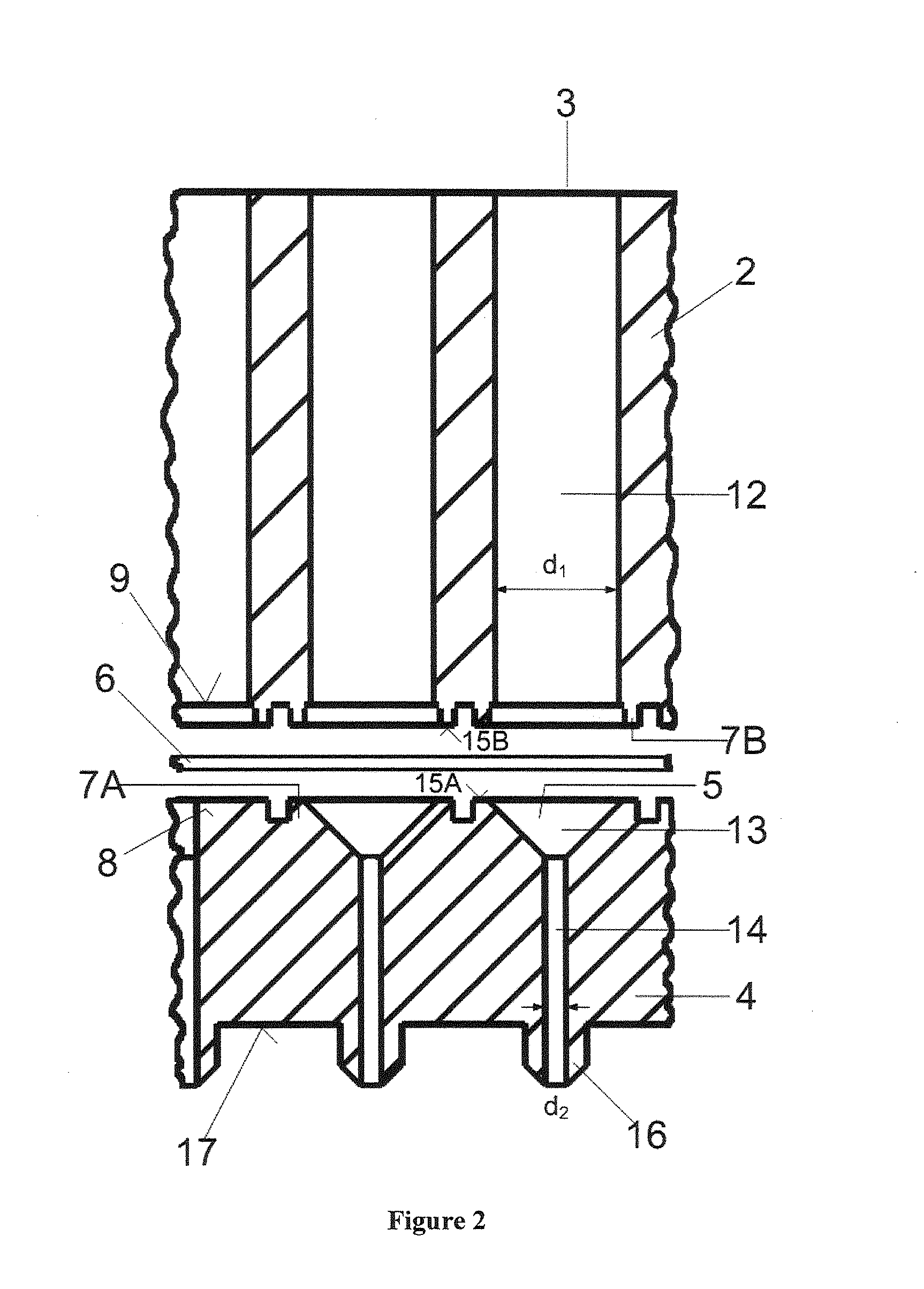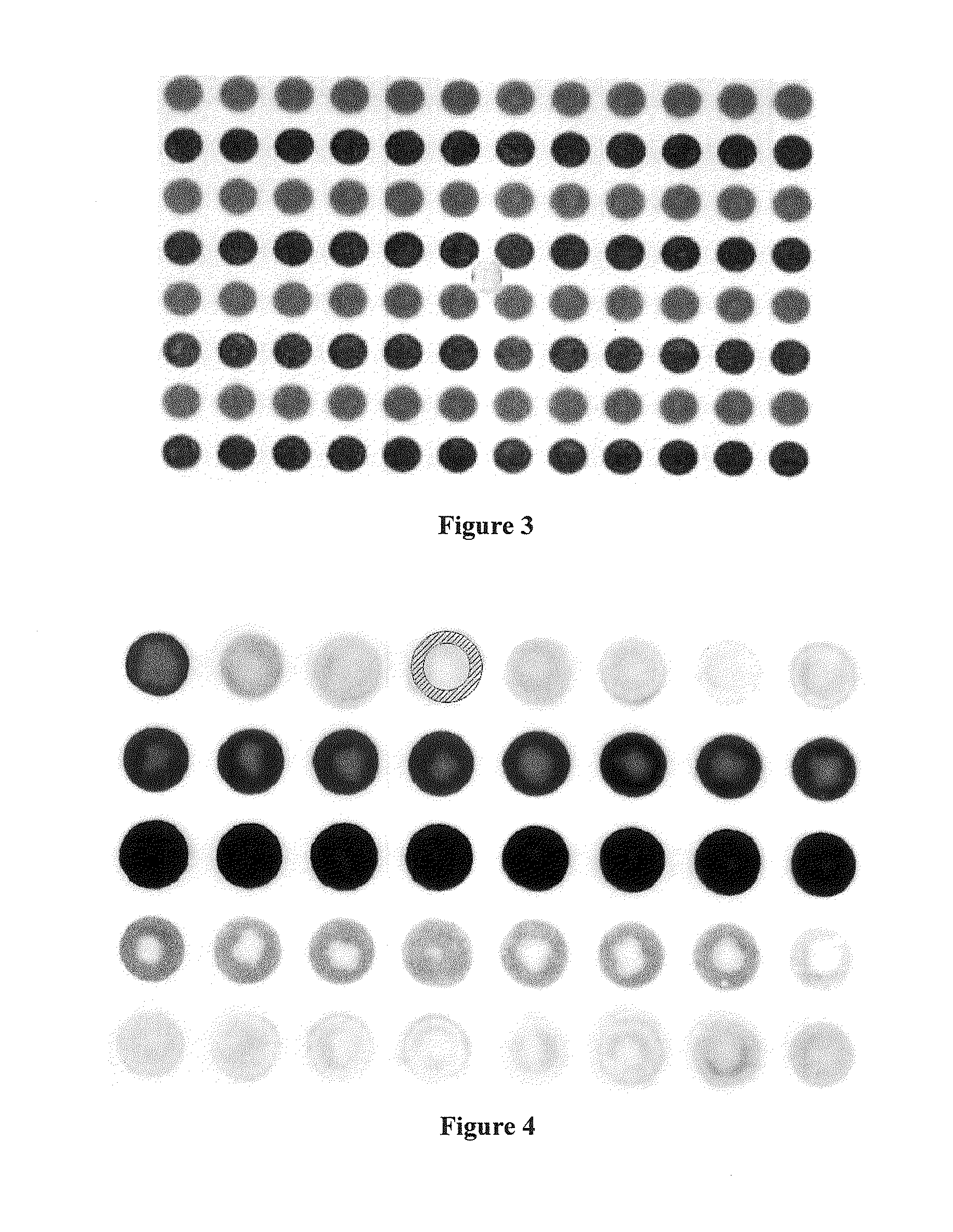Multi-well plate with filter medium, and use thereof
a filter medium and multi-well technology, applied in the field of multi-well plates, can solve the problems of unsuitable devices for parallel screening of a plurality of samples, unoptimized fluid discharge from cylindrical wells, and inability to carry out individual tests, etc., to achieve rapid and inexpensive production, promote undesired radial cross-diffusion of analytes, and high flow rate
- Summary
- Abstract
- Description
- Claims
- Application Information
AI Technical Summary
Benefits of technology
Problems solved by technology
Method used
Image
Examples
example 1
[0064]Detection of the suppression of cross-contamination between adjacent reaction spaces of the multi-well plate 1 according to the invention with sealing means 7a and 7b arranged in pairs on the upper part and lower part
[0065]Dye tests are carried out to detect how the individual sections of the filter medium 6 enclosed in the reaction spaces are sealed off by the sealing means 7a and 7b in respect of binding substances. The filtration medium 6 consists of three sheets of a microporous cellulose membrane (surface area per sheet: 86 cm2, thickness of each sheet 250 μm) with quaternary ammonium groups as anion-exchanging groups (Sartobind® Q Membrane from Sartorius Stedim Biotech GmbH) and, after wetting by RO (reverse osmosis) water, is placed in the receiving area 11 of the lower part 4. After it has been screwed together with the upper part 2, the lower part 4 is positioned on a vacuum-generating suction device. The reaction spaces of the assembled multi-well plate 1 are filled,...
example 2
[0071]Detection of the exclusion of cross-contamination between adjacent reaction spaces by means of the phosphate test according to Cooper
[0072]A multi-well plate 1 according to the invention, as shown in FIGS. 1 and 2, is preferably used for applications in the field of high-throughput screening, in which different charging conditions in respect of the buffer composition occur in the individual wells. A precondition for this is that the salts contained in the buffer solutions also cannot pass from one well to an adjacent well by radial cross-diffusion. To detect that inorganic salt solutions in the wells also do not cause cross-contamination, the multi-well plate 1 is equipped with three sheets of an ion exchange membrane from Example 1, pre-wetted with RO water, and is then wetted column by column with 0.5 ml phosphate solution NaH2PO4 at a concentration of 0.16 g / l per well. All other wells are filled with distilled water. After 15 minutes the liquids are conveyed by a pressure ...
example 3
[0074]Recording breakthrough curves in the high throughput method with the multi-well plate according to the invention
[0075]Breakthrough curves of membranes are generally plotted by the continuous charging of filtration units. They show whether and to what extent a membrane is able to bind or hold back one or more substances. Depending on the surface area of the membrane used, the most expensive substances often have to be applied in a large quantity. Therefore, for economic reasons, simultaneous multiple tests cannot be carried out.
[0076]The multi-well plate according to the invention allows a breakthrough curve to be recorded with minimal use of analytes. A protein solution is introduced into individual wells at a constant concentration, but in different volumes. When the charge concentration is known, the breakthrough can be recorded and assessed by analysis of the permeate. For technical purposes, it is often sufficient to detect when a breakthrough of at most 10% of the protein...
PUM
| Property | Measurement | Unit |
|---|---|---|
| surface area | aaaaa | aaaaa |
| concentration | aaaaa | aaaaa |
| concentration | aaaaa | aaaaa |
Abstract
Description
Claims
Application Information
 Login to View More
Login to View More - R&D
- Intellectual Property
- Life Sciences
- Materials
- Tech Scout
- Unparalleled Data Quality
- Higher Quality Content
- 60% Fewer Hallucinations
Browse by: Latest US Patents, China's latest patents, Technical Efficacy Thesaurus, Application Domain, Technology Topic, Popular Technical Reports.
© 2025 PatSnap. All rights reserved.Legal|Privacy policy|Modern Slavery Act Transparency Statement|Sitemap|About US| Contact US: help@patsnap.com



